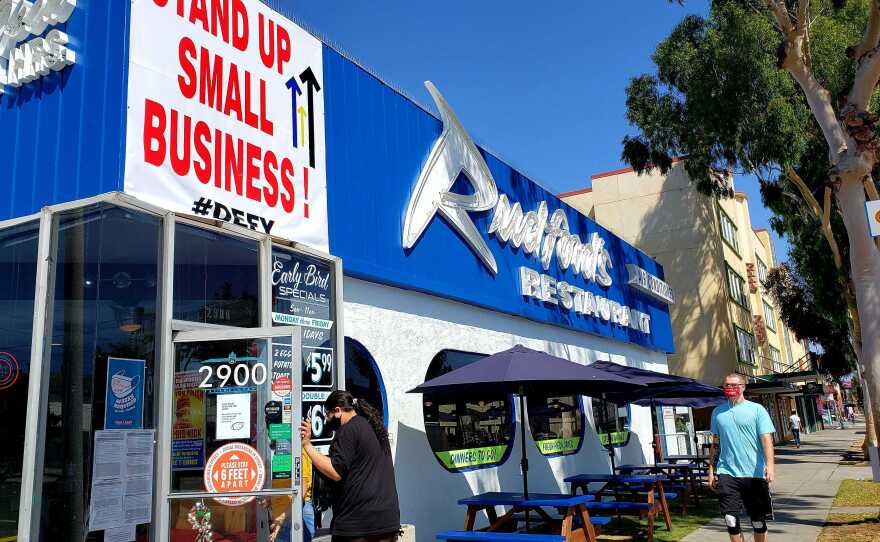San Diego County this week narrowly avoided more business closures and school reopening delays.
Many establishments are already limited on how many customers they can serve indoors, and the region’s case rate placed us just below a threshold that would’ve triggered a total shutdown of most indoor spaces.
The back and forth over what can open and when has left San Diegans with many questions about reopening — and we asked you to share them with us.
KPBS Health Reporter Tarryn Mento collected your questions and brought back infectious disease specialist Dr. Christian Ramers to provide the answers.
Ramers, the chief of population health at Family Health Centers of San Diego, sits on regional task forces dedicated to equitable recovery from COVID-19 and expanding testing in the region.
This interview has been edited for brevity and clarity.
Q: "Why aren’t we being told where the community outbreaks are? Why is it important to keep that information confidential when it could help people avoid contracting the virus?" — Steven Johnson
A: It's a good question, it's one that the press has been asking the county officials really all along. and different counties have taken different approaches to this. For example, Los Angeles County, I think, is very public with where the outbreaks are occurring. The response that I've heard from the county officials and again, I don't work at the county, but in speaking for them, they've said that it is difficult to get contact tracing information when you basically publicly post this information and as soon as people feel scared to provide information, that makes that job a lot more difficult. So that's the answer that they've given.
I think it is some useful information if you were to do it by ZIP code to tell people sort of where the hotspots are. So, you know, there's a fine line in here in respecting privacy and then getting people to give us the information that we need for contact tracing versus saying exactly where things are. I don't know what the right approach is. I don't think anybody does, and different countries and different counties have taken different approaches to this.
KPBS obtained some information about community outbreaks by ZIP code and is part of a lawsuit against San Diego County to uncover more specific details.
Q: "My question was around opening up movie theaters in San Diego. Are they open? I've heard that they're open. And if they are, do you have to wear a mask when you go?" — Jacob Reimers
A: Movie theaters under the red tier, which we're currently in, say that they can be open with modifications at a 25% maximum capacity or 100 people, whichever is fewer. ... I personally think universal masking is a good idea. It's worked incredibly well and there's great scientific data for it decreasing transmission in other settings. ...Then the other piece of this is how much can the county enforce these things? So it's a little bit of the consumer buyer beware. I would not feel comfortable going into an indoor space where nobody was wearing masks. That's just a very high-risk situation.
Q: "Once the vaccine is approved, what would we expect roll out of the vaccine to look like? How long will it take? How will specific priority groups be determined? Who gets to decide what those look like? And at what point will vaccination coverage be considered high enough to allow for broader reopening of activities?" — Mindy Hochgesang
A: There will be a limited amount of vaccine available in the beginning, and there are some very smart people thinking about how to phase this out to the public. The one that I would refer you to is from the National Academy of Sciences, Engineering and Medicine. They've developed a very beautifully phased approach where phase one, two, three and four sort of allowing the populations at highest risk to go first with a lot of data and a lot of thought behind this. ... Health care workers are first in line, as well as first responders such as firefighters and policemen.
Phase 1B would include everybody of all ages with comorbid and underlying conditions who are at the highest risk of dying of COVID, and then also included in phase one is older adults living in congregate settings, specifically nursing facilities.
Phase 2 brings in more essential workers...that includes people like farmworkers, people working in meatpacking plants, teachers; definitely also people of all ages with comorbid conditions, people in homeless shelters, in group homes and congregate settings not included earlier, such as prisons and jails.
Then phase 3 gets more to the general population with young adults, children, other essential workers. Phase 4 would be everybody. Now, the timeline of that obviously is going to take a while. Even if we have 10 million doses by the end of the year, that's going to go to health care workers first and then people with diabetes and hypertension or who are older, who have the highest risk.
There's been concern about equitable distribution... and the CDC has something called the Social Vulnerability Index, which actually takes into account all of these upstream social determinants of health, such as poverty, race, ethnicity, education — there's actually a map of the United States. It uses 15 pieces of data from Census information to create sort of a heat map of places in the U.S. and places in our community that have higher rates of COVID. I think that's a really nice way to do it, actually, to give people the vaccine first that have the highest risk of dying, and then secondly, that have the highest transmission.
The last thing I'll say is that we are already starting locally to discuss this, how it actually rolls out. We'll have to do it with our existing systems, with CDC and local health jurisdictions, but people are already starting to talk on the local level at San Diego County about how we're going to roll this out.
Final part of your question is when do we get to herd immunity? The best modeling that I've seen is that we have to reach about 70% in order to have a real population effect of herd immunity. What does that mean? It means that the combination of having had COVID and having immunity from the actual infection, plus the number of people that get vaccinated needs to reach about 70 %.
And I'll tell you the one thing I'm very, very concerned about, and everybody I know that's an infectious disease or public health doctor is concerned about this, is: if we have enough vaccine hesitancy or reluctance of the population to get the vaccine, we may not get to that 70%. I've seen a recent survey that said 50% of Americans right now are prepared to get a vaccine. This is a moving target because, of course, it all depends on the transparency of the vaccine research protocols.
Q: "How do we keep our kids and our families safe if and when schools reopen and require the kids to go back to face to face?" — Laura Carr
Boy, this is a very complicated question ... one major point I think has been lost a little bit and not emphasized enough is that school-based transmission is totally dependent on community-based transmission.
Our schools are not isolated islands. They exist within communities. Students that go to school interact with older people who are their teachers, their administrators. They come home to older people who are their parents. They interact with their grandparents. A school is completely embedded in a community in places where we've seen successful face to face school reintegration, and they have been places that have already flattened the curve so much in the community that it looks like it's safer. The CDC recently issued an also color-coded guide to say when it is safe to go back to school.
And it does have to do with basically community transmission as the most important factor. I think it's a little bit arbitrary to choose what level of community transmission is safe enough. But the people at the CDC sort of chose actual thresholds there. So that, I would say, is the overall point of when we know it's safe. Beyond that... it's actually the basics, not the fancy high tech machines that that really make the difference.
Masks absolutely, universal and correct use of masks, physical distancing cohorts of people into different days, if you can, or keeping them separate, avoiding really large congregate settings and then going outside as much as possible. The stuff like the UV light kind of things and the super blowers that can mist anti-virus material throughout the room. Those are kind of window dressing. I think the most important stuff are the basics and the fundamentals that you've been hearing about all along.
They're not sexy or anything, but staying away from people, keeping masks on, washing your hands and staying away when you're sick. Those are the most important things.
Q: "Can Dr. Ramers address the PCR cycle threshold being used in the labs that do San Diego County's test and explain why it is considered precise enough to dictate public policy and business and school re-openings?" — Anonymous
PCR is a chemical reaction that amplifies very, very small amounts of DNA or RNA from a virus or a bacteria. The cycle threshold refers to how many of those cycles it takes to actually get a positive result. So the higher number you get, the lower amount of virus is actually there. What we've seen is that in people, for example, who get infected with COVID and they have a positive PCR test, if we were to test them after their infection, in many cases it stays positive for weeks.
I had a patient who had an eight-week positive test after being sick, and we know that person is probably not infectious. So the question is, is PCR too sensitive? And there's a lot of discussion about bringing in a different kind of test, like an antigen test, which really would only detect those who are very, very infectious at the initial rates of infection versus a PCR, which really is a very, very sensitive test, some people have said too sensitive.
Now, I think the question is getting at maybe overcounting cases and counting positive PCR as people that maybe don't necessarily have severe enough COVID. But really, that's the standard test that we have right now. And PCR tests are really the best that we have. I will address that question and say that a positive PCR after somebody has already been diagnosed with COVID is pretty useless.
It's just a single positive. It tells us you do not need to have a follow-up test once you've been positive. We use days and symptoms of 10 days and being symptom-free in terms of determining infectiousness.
Q: "I'm wondering why the kids haven't been on higher priority as all the plans have sort of manifested. We're making all these innovations to allow restaurants to open outdoors and now indoors and to do all of these things and I just wonder why there hasn't been a more concerted effort to make things work for kids as we try to reopen things." — Chris Nafis
Boy, that's a really important question. I think in a cynical way, we would say that kids don't generate major economic productivity the way that bars and restaurants do. It's a philosophical question that I think we need to think about as a society. What's more important to us, to open bars or open schools? I'll also say that there's been a little bit of this mythology that kids are not affected by this at all. I think that's not true in a couple of ways, and I'll tell you why.
It appears kids can randomly develop a kind of syndrome which can be life-threatening....Secondly, they are spreaders. So we didn't initially think the kids could spread all that easily, but they certainly can. So we've seen places with community spread. We've even seen with the local outbreak at San Diego State University that they are not an island.
They have already started spreading cases into the local community. So, Chris, I think it's a very good question about what we value in our society. I tend to believe that a society is judged by how we treat our most vulnerable and that we should probably be treating kids with a little bit more care during this whole thing. But it's just is not the way that our society seems to run.
Q: "How does contact tracing work in San Diego County? And will there be or should there be any changes to the process as we move into flu season?" — Charity Terry-Lorenzo
Contact tracing works when we really try to be as quick as possible to identify those that are positive cases and then someone who has a contact trace interviews that person and really tries to go through their infectious period and see who else that they exposed. Then they try to get the names and numbers of those people and contact them and just notify them that they have been actually exposed to the disease.
These contact tracers need to be members of the community who are trusted, who are competent in different language skills and who can get information out of people in a trusting way. It's not always a straightforward thing that someone calls and says, hi, I'm from the government and I want you to give me your information. Many people are reluctant to do that. The idea is that in places where contact tracing has been successful, it is a very, very useful way to shut down further community spread.
So many countries have done this very, very successfully. Asian countries, Taiwan, South Korea have done very, very adequate and good contact tracing. And that has allowed the outbreak to be contained.
What happens with flu, I think contact tracing will still proceed the way that it generally goes because we're more concerned about COVID actually than we are with flu generally in a flu season. We don't have this robust apparatus of contact tracing for flu. But it does bring up an interesting point that we as health care providers are going to really struggle because there's a big overlap between the symptoms of flu and COVID. We're going to have to work on how we do testing and distinguish the two.
They affect different populations differently. Flu is much more deadly in younger people and pregnant women. COVID is much more deadly in older people and those with pre-existing conditions. The treatments are totally different. So we are certainly going to have to distinguish somebody coming into our clinics with fever and cough. It's going to make it way more complicated. And so a lot of practitioners are saying, please, please, please get your flu shots this year.
Flu seasons are variable every year. Sometimes we have really light years. Sometimes we have very severe years. And if we just happen to have a severe flu year this year, it's going to be a nightmare with the interacting in the confusion that it creates with COVID.
Q: "Will having a flu vaccine provide any protection at all against COVID-19?" — Diana Biegener
A: The answer is probably not. The immune system is incredibly specific to the proteins on the outside of the virus. This question was actually raised by the President earlier: Does the flu vaccine help against COVID? And the answer is no. Even the vaccines that we will have for coronavirus, even if the scientists do everything right and they develop things really targeted precisely to that spike protein on the outside of coronavirus, we don't even know if that will work.
The immune system is very complicated, but it's also very, very specific. A flu vaccine will protect you against the flu. It's different every year. They choose the strains in advance, trying to anticipate what's going to come from the Southern Hemisphere up to the Northern Hemisphere. Some years it's better than others, but usually, I'd say on average, we have at least a 50% protection rate from the flu vaccine, and that's enough to really just keep transmission down.
But it doesn't really provide you cross-protection to the coronavirus. We need a specific coronavirus vaccine for that, and those are all being studied right now.








